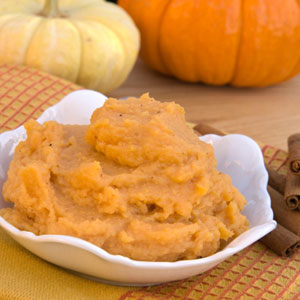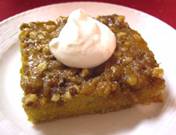
Pumpkin meat is very high in carotenoids. Carotenoids are really good at neutralizing free radicals, nasty molecules that can attack cell membranes and leave the cells vulnerable to damage.
They are also high in lutein and zeaxanthin, which scavenge free radicals in the lens of the eye. It’s found that help prevent the formation of cataracts and reduce the risk of macular degeneration, a serious eye problem than usually results in blindness.
Besides these antioxidants, pumpkins have a lot of common nutrients, like iron, zinc, and fiber. Iron, of course, is needed by red blood cells. Zinc deficiency may be related to osteoporosis of the hip and spine in older men. And fiber is important for bowel health.
Pumpkin seeds are very high in protein; one ounce of seeds provides about seven grams of protein. They also contain copper, iron, magnesium, manganese, phosphorus, and zinc. And their oil is high in phytosterols, plant-based fatty acids that are chemically so like cholesterol that they can replace it in the human body—contributing to the reduction of blood cholesterol levels.
Pumpkin seed oil is high in essential fatty acids (EFAs). EFAs have many benefits, among them the maintenance of healthy blood vessels and nerves and the lubrication of all tissues, including the skin. It can help reduce cholesterol levels in the blood and it also contains vitamin A, which (among other things) helps keep our eyes healthy and stimulates the T cells of the immune system to help fight off infection. And it has vitamin E, which acts like lutein and zeaxanthin to get rid of free radicals.
Tips for using pumpkins in the kitchen:

The bigger the pumpkin, the tougher the meat; that's why pie pumpkins, also called baking pumpkins, are so much smaller than the ones used for carving. But you can still cook and eat the meat of a carving pumpkin; it just won't be quite as soft.

If you don't like the taste of pumpkin, try adding a small amount of orange juice.

If you're planning on cooking rather than carving the pumpkin, you don't have to go to the trouble of scooping out the inside after you remove the top. You will have to remove the seeds, but after that you can just cut the entire pumpkin into pieces, remove the skin with a peeler, and boil the pieces in water for about 20 minutes. After the pieces have been boiled, drain the water and either mash the pieces by hand or puree them in a blender. (NOTE: save the drained water, let it cool, dilute it and water houseplants with it—they LOVE this TLC!)

A whole pumpkin can be stored at room temperature for up to a month, or in the refrigerator (if it'll fit!) for up to three months.

Besides pies, pumpkin can be used to make pudding, custard, cookies, and of course pumpkin bread. But it's also great as soup, or as a side dish for the main course of a meal.

Pumpkin seeds can be sprinkled with oil and other flavorings and roasted at 300° for about 30 minutes. However, most nutritional experts believe that roasting weakens a lot of the nutrients, so they recommend that the seeds be eaten raw. Whole seeds can be added to steamed vegetables, salads, cereals, and cookies, and ground seeds can be added to burgers.

Pumpkin seed oil can be used in recipes (it's popular in Austrian dishes) or just taken by the teaspoon or tablespoon, like other EFA oils (for example, flax seed, evening primrose, borage seed, or black currant seed oils).
So the next time you're carving a pumpkin and are tempted to just throw out the inside—don't! Save it, cook (or bake) it, and eat it instead. And if you're not into pumpkin carving, don't pass by those small specimens in the Produce section.
Finally, if all that cutting and boiling is too much work or too time-consuming, get yourself a can of already-cooked pumpkin. There are lots of ways to enjoy the nutritional benefits of this uniquely American food. Now here’s a great pumpkin recipe found on one of our favorite websites, www.preparedpantry.com:
Pumpkin Pie Squares

This recipe is designed for a small, a medium or a large batch. Use an 8 x 8-inch baking pan for the small, an 8 1/2 x 13-inch pan for the medium, and a 10 x 15-inch pan for the large.
Preheat the oven to 375 degrees. For the crust, cut the butter into the sugar, oats, and flour until crumbly. Press the ingredients into an ungreased baking pan, across the bottom and up the sides. Bake the crust for 15 minutes.
For the topping, cut the butter into the nuts, flour, and brown sugar. Set aside.
For the filling, combine all ingredients in and whisk until smooth and all ingredients are evenly distributed. Pour into the baked crust. Bake for twenty minutes and remove from the oven. Immediately, spoon the topping over the filling and bake for another 15 to 20 minutes or until a knife stuck in the center comes out almost clean. Cool on a wire rack. Garnish with whipped cream.
(If YOU have a smart idea, won't you share it? Life is so much easier and we accomplish so much more when we pool our resources. And after all, we're all in this together. So email
patty@dvo.com or
alice@dvo.com with YOUR Smart Ideas!)
Contribute to the Cook'n Club!
DVO would love to publish your article, prose, photography and art as well as your cooking, kitchen and nutrition tips, tricks and secrets. Visit the Newsletter Submission / Win Win for All section in our Forum for more information and details.



